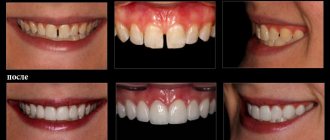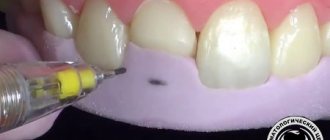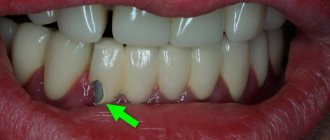home
Aesthetic dentistry
Dental restoration
Don't despair if your teeth become chipped, cracked, or if part of a tooth breaks off completely. The specialists of the PROFI-Dent clinic can easily and quickly cope with any dental problems.
Modern dental restoration allows not only to qualitatively eliminate the existing dental defect, but also to correct the shape, position and appearance, making the dentition impeccably straight and the smile luxurious.
Your teeth require aesthetic restoration if you have the following problems:
- carious lesions of tooth tissues;
- cracks, chips of tooth enamel;
- presence of a tooth of irregular shape, size or color;
- enamel defects resulting from trauma;
- darkening and pigmentation of the enamel that cannot be eliminated by whitening (tetracycline teeth, fluorosis);
- chips, gaps between teeth;
- old dark fillings;
- wedge-shaped defect, enamel erosion;
- loss of more than 30-50% of tooth tissue, which cannot be compensated by simple filling.
Dental restoration of teeth allows using different materials to recreate lost or damaged tissue, eliminate enamel defects and maintain a brilliant smile at any age. We offer the most affordable prices for dental restoration in Moscow.
Dental restoration methods in Moscow
The PROFI-Dent dental restoration clinic provides high-quality dental care to everyone who values their health and is committed to an impeccable result.
In our dentistry, dental restoration is carried out using two methods:
- Direct – recreating the anatomical shape of the tooth by layer-by-layer application of composite materials.
- Indirect - tooth modeling with artificial segments (veneering).
We treat each patient with the utmost attention, doing everything possible to solve the dental problem in the shortest possible time, while the cost of dental restoration in our clinic is one of the lowest in Moscow.
All procedures and manipulations are carried out using modern equipment and advanced materials. The modern dental restoration technologies used by our specialists make it possible to achieve truly exceptional results, preserving maximum healthy dental tissue.
What is the best material to make restorations of anterior teeth from? Ceramics vs. light seals...
As a small survey on my website showed, many of us will definitely go to the dentist only if we suddenly notice a deterioration in the appearance of our front teeth. But who should I go to? To a therapist so he can install a light filling? Or to a prosthetist to make a ceramic veneer? The questions are actually difficult and ambiguous... Even dentists often break their spears in disputes about what is best to do and when... What can we say about patients then! I will try to talk about the pros and cons of both light fillings and ceramic restorations . Well, let’s try to understand the indications for both.
The division of dentists in our country into “therapists” and “orthopedists” often creates situations where doctors unjustifiably juggle indications for choosing one or another restoration technique. Simply put, they choose not what will be optimal for the patient, but what they can do. Or worse, what's better for their pocket. In this case, an orthopedist can sharpen a barely damaged tooth for a crown or veneer because he does not know how to use filling material. And the therapist will sculpt a huge filling for the entire tooth, because he does not know how to take impressions to make a crown or ceramic veneer . Referring a patient to a colleague means losing money. In our hyper-materialistic times, and even in conditions of fierce competition, not all dentists will put the needs of the patient at the forefront in such a situation. The division of inseparable, in my opinion, skills and abilities is a big problem in our dentistry. Especially the state one. Well, yes, God bless her. Why did I write this? In large ministerial offices with expensive furniture, they are clearly not thinking about how to make our life more correct and easier. And therefore, friends, you will have to understand some of the intricacies of the process yourself. And in controversial situations, try to hear the opinion of both the “therapist” and the “orthopedist”. Well, my article will help you.
So. Let us briefly examine how a filling from a light composite is made. In order not to repeat myself, I discussed the entire modern restoration protocol in the article “Treatment of caries.” It is the same for any teeth. But when restoring the front ones, you need to remember some nuances.
Composites for filling fillings, even the coolest and most modern ones, are mostly plastic. A number of disadvantages follow from the properties of this material:
— instability of restoration over time. This applies to both color and shape. When we eat and brush our teeth, we mechanically constantly act on the filling material. It slowly gets scratched, loses its shine (even if the dentist initially polished it well), becomes dull and rough. This leads to plaque retention on its surface. At the same time, under the influence of dyes from food (or, for example, when smoking), such a matte surface also quickly darkens, revealing the presence of restoration to everyone around.
— low mechanical strength quickly enough (within 5-7 years maximum) leads to the appearance of microchips of the composite and disruption of the seal’s fit to the tooth. This can cause a cosmetic defect in the form of a stained strip between the filling and the tooth, and the re-development of caries.
— many composite filling materials do not have sufficient similarity in optical properties to natural tooth tissues. As a result, no matter how hard the doctor tries, the restored area will differ in appearance (color, degree of transparency, surface texture) from healthy tissue. Not all patients will be satisfied with such aesthetics, which, moreover, will only worsen over time.
- lack of normal fluorescence in many materials. This can lead to the fact that at a disco in ultraviolet light, all your fillings on your front teeth will look like a kind of “black holes”, which will not give your smile any special beauty.
That's probably enough about the main disadvantages. Now we can’t help but talk about the advantages of light fillings for the restoration of front teeth.
- ease and speed of use. An hour and a half in the doctor's chair - and everything is ready. To manufacture ceramic restorations, it is necessary to take impressions and involve a dental laboratory. This increases the time. You need at least two visits, but in fact, with all the fittings, you often end up with more. In addition, this naturally affects the cost. The price of a ceramic veneer is usually at least 2-3 times higher than the cost of a light filling . Hence its next advantage...
- relative cheapness;
- high maintainability. Those. If a ceramic veneer chips, you will have to completely remove it and redo it. If a composite restoration breaks, you can easily put a “patch” on the problem area.
- less aggressive tooth treatment. When placing a new light filling, the doctor, preparing the tooth for restoration, removes only old fillings and carious tissue. Nothing extra. When making ceramic restorations, it is often necessary to remove some healthy tissue.
We've sorted out the pros and cons... now I propose to move from theory to practice. And using several real clinical cases, we will consider the above-described properties of light fillings and ceramic restorations.
This photo shows multiple composite fillings and veneers on upper anterior teeth approximately 2 years after fabrication. The black arrow shows how the filling on tooth 21 stands out. The difference is emphasized by the brown-painted border between the filling and the tooth. The blue arrow marks tooth 11, on which a composite filling covers the entire front surface. It is monochromatic, matte, so it obviously doesn’t look very good aesthetically. In addition, in the cervical part, due to a violation of the marginal seal, there is recurrent caries (a brown strip along the gum). The green arrow indicates a canine (tooth 13), on which the same composite veneer has completely fallen off. Which, by the way, was initially the main reason for the patient’s contact with me.
Overall... a depressing sight just a couple of years after treatment. Of course, this case is not an example of high-quality work with composite materials. But the indications for their use are clearly exceeded here.
Next example...
The green arrow in this photo illustrates that after some time the composite light filling can move away from the edge of the tooth, opening the way for microflora in its “insides”. This can happen especially quickly with increased load on the tooth and poor hygiene. In general, poor hygiene and composites are poorly compatible things. The black arrow shows the area of the tooth restored with a filling and noticeably different in color and degree of transparency from the surrounding tissues.
Another case...
These composite “restorations” are also no more than 5 years old. Here you can clearly see how over time they lose their smoothness, begin to accumulate plaque, and are stained with food dyes. As a result, the most visible front teeth have such a deeply sad appearance. Black arrows show areas that clearly differ in the degree of shine from the tissues of your own tooth. This is because composite materials are not able to maintain a polished, smooth appearance for a long time. The green arrow indicates a conventional plastic crown, which this patient also had for about 5 years. Its appearance shows that ordinary plastic and composite are related in chemical nature. They look approximately the same in operation. Equally bad... and the longer they last, the worse the appearance becomes. In addition, the monotony and lack of natural translucency characteristic of our natural teeth are clearly visible.
And finally, the last case is an illustration of exceeding the indications for the use of light composites in the restoration of anterior teeth...
To what has already been said and shown above (dull surface, chips, staining of borders), we can add the indicative fact of plaque accumulation at the border between the composite filling and the tooth. The matte surface, devoid of polished gloss, also helps to retain plaque and make it difficult to remove when brushing your teeth. The result is chronic gingivitis and recurrent caries along the border between the filling and the tooth. All this is shown by black arrows - the gums are red, swollen, and bleed when touched. These fillings are also about 2 years old... nothing at all.
Now let's take a closer look at ceramic restorations; we will mainly talk about ceramic veneers.
I already talked about this clinical case of front teeth prosthetics a little earlier.
Here, in addition to the need to prosthetize a missing tooth using a crown on an implant, it was important to eliminate the corner defect on the neighbor and increase its width (you can read the link for why and why this was necessary). The dotted line shows the contours of the required “extension” of the tooth. In this situation, a light seal could also be used. But it would have to cover almost half a tooth. And you have already seen what massive composite restorations look like after a few years... In addition, the crown on the implant was made of ceramics. As a result, we would get dissimilar materials standing nearby in one place - ceramics, composite and natural tooth tissue. Not only is it not always a feasible task to fit dissimilar materials into a single form. But the most important thing is that over time, due to the aging of the composite, the difference in appearance would definitely become very noticeable. If we add to this the high demands of the female patient on aesthetics, then the choice is obvious - ceramic veneer. Which is what was done.
Here you can see that to make the veneer, we had to process not only those places where tooth extension was directly required, but also where it was not required. As I said, tooth treatment for ceramic restoration is almost always more aggressive. It must be said that the thickness of the tissue removed is minimal (about 0.5-0.8 mm). A beautiful and most importantly long-term result requires some sacrifices.
The final result speaks for itself. And there is no doubt that these teeth will look the same a year, and 3, and 5 years later... And if you don’t believe me, then look further.
Another illustrative case... Let's compare the appearance of ceramic veneers 3.5 years after their manufacture with what we saw in cases with light fillings.
Initial situation. Lower incisors, increased abrasion (which indicates increased stress) and poor hygiene. The conditions are quite similar to those we saw in the first photographs with composite restorations. We have already seen how light seals serve in such conditions. What about ceramics?
This is what the teeth looked like on the day the ceramic veneers . The teeth became lighter, smoother, with a natural surface texture and translucency. After polishing the margins, slight trauma to the gums is noticeable. What happened to them after 3.5 years?
But nothing... The teeth look as if the patient and I parted just yesterday. True, not only the appearance of the teeth remained unchanged, but also some of the young man’s neglect of hygiene. With all this, pay attention only to a slight brown coating on the neck of the teeth. It was easily removed in 1 minute with a brush and paste. In this case, it is worth paying attention to the appearance of the ceramics. It has absolutely lost neither shine nor color. The gums around the teeth are absolutely healthy. And we don’t see a single chip. But with such hygiene and dental restoration with composite light fillings, the appearance of this patient’s teeth and gums would be completely different... so, as they say, feel the difference! Unchangeable appearance and long service life are the main advantages of ceramics over composites.
***You can read more about this clinical case of restoration of front teeth with ceramic veneers at the link.
And one more visual illustration. If I really wanted to, I could be accused of showing poorly executed light fillings and comparing them with well-made ceramics. The next case should put everything in its place. The author of the work and photographs is Dr. Sergey Maksimov (Moscow).
This clinical case clearly demonstrates the replacement of “artistic cosmetic restorations” made of composite with ceramic veneers. Here it must be said that the composite “arts” are made quite decently and accurately. But... a composite is a composite. After a short time, we see all the delights of its use - dullness, monotony of the teeth, and problems with the fit of fillings in the cervical part of the teeth. Well, you can clearly see what replacing the composite with ceramics gave this patient.
The same work, but on the lower jaw. Numerous chips, dullness, accumulation of plaque in the cervical area (green arrow), inflamed gums... All this happened with composite. And all this disappeared when it was replaced with ceramics. A very clear result.
So, are light fillings really that bad and there is no use for them in the aesthetic restoration of anterior teeth? No, that's definitely not the case. And here is the last example from my own practice.
In this case, the girl came in with a front tooth injury. What we see in the photo is a small chip in the corner and cutting edge. At the same time, excellent hygiene, intact (i.e., unharmed) neighboring teeth, correct bite. In this case, the right place is for a small cosmetic filling made of composite.
The final result, with proper skill in handling the composite material, can be no worse than ceramic restorations in aesthetic terms. At the same time, one of the best materials for artistic restoration, Enamel HFO, was used, which has a wide selection of colors and shades. It allows the doctor, literally like an artist, to apply different shades with a brush, imitating any natural features of color, transparency and other characteristics of our teeth. And at the same time, such a restoration will still require periodic polishing to maintain its original shine. In addition, the area of “gluing” of the composite filling with the tooth is very small, and the load on this area of the tooth is large (it is with the cutting edge of the central incisors that we bite off food). This means that such a tooth will now have to be handled with care.
It's time to draw conclusions. All the clinical cases I showed confirm what I wrote about at the very beginning. Every technology and every material has the right to life, the most important thing is the indications. I don’t pretend to be the truth, but I’ll try to determine where what works better.
Your choice is a ceramic veneer if:
– damage to the front tooth affects more than 1/3 of the visible surface
- you are demanding of aesthetics
— you want the restoration to serve without problems for more than 5 years without losing its appearance
- you have damaged the cutting edges of the entire frontal group of teeth due to pathological abrasion (well, or any other damage to several front teeth at once)
Your choice is a light seal if:
— the tooth defect is minor (less than 1/3) or is out of sight
- you have excellent hygiene
— Are you ready to go every six months to a year to polish the filling?
— Are you ready to change it every 5 years (on average)
— You need temporary restoration
— You need an inexpensive restoration
— You are not very picky about the appearance of your front teeth
Of course, these are just general recommendations. We must not forget about what your particular dentist can offer, what he is better at, what he does better. Although, ideally, any technique and material should be equally accessible to him. Only then will he be able to offer the best solution specifically for your situation. And now you can consciously approve of it... or refuse.
Where to get dental restoration done in Moscow?
Since dental restoration is a real art that requires the highest professionalism and considerable talent from the dentist, it is necessary to carefully choose a clinic and a specialist.
Dentistry "PROFI-Dent" is:
- an integrated approach to each clinical case;
- a team of true masters of their craft;
- the latest technical equipment;
- advanced materials and restoration technologies;
- ideal results in the shortest possible time.
The cost of aesthetic restoration work in our clinic will surprise you with its democratic nature, and the result will exceed your expectations!
Correction of position and curvature
For minor defects - crowding, uneven teeth, gaps between teeth - can be corrected with veneers or composite material. If significant correction of the bite is required, the patient is recommended to use braces. We offer patients several options for corrective systems, differing in the level of aesthetics, material and device. In the most difficult cases, surgical intervention is resorted to.
How much does tooth restoration cost in Moscow?
By contacting PROFI Dent dentistry, you will be convinced that inexpensive dental restoration in Moscow is by no means a myth, but a real opportunity to make your smile beautiful.
The cost is influenced by many factors - the complexity of the case, the amount of work, the technology used, the price of the material, the need for additional procedures, etc.
The doctor will announce the final price during the consultation, after the examination, and you can familiarize yourself with the price list now.
| Price list for prosthetics at the PROFI-Dent clinic | |
| Restoration of wedge-shaped defect, enamel erosion | from 3,000 rubles |
| Restoration of the frontal group | from 5,000 rubles |
| Filling made of light-curing material | from 2,200 rubles |
| Artistic restoration made from light-curing material | from 5,000 rubles |
| Ceramic-composite veneer | from 8,000 rubles |
| Installation of dental jewelry | 1,000 rubles |
Alternatives to composite restorations –
An alternative to composite filling materials is ceramics, i.e. veneers, crowns, restorative inlays made from ceramics. The price corresponds to the quality, and therefore the cost of ceramic restorations will be significantly higher than composite dental fillings.
- Veneers – if your front tooth is destroyed mainly only on the front side, and the lingual part of the tooth is not very damaged, then in this case the best alternative to restoration would be a ceramic veneer. Precisely from ceramics, because ceramics do not darken at all and do not lose their shine over time. The only drawback of this type of prosthetics is its cost.
- Crowns (metal-ceramics or ceramics) - if your tooth is destroyed by more than 1/2 and especially if it is also depulped, we recommend abandoning restoration in favor of an artificial crown. By the way, restoring a tooth “from the root” costs the same as it costs to restore a tooth with a metal-ceramic crown.
- Inlays - if you need to restore a lateral chewing tooth, then an alternative to restoring a tooth from a composite filling material can be a restorative inlay. In terms of reliability, service life and aesthetics, ceramic inlays are at least 3-4 times superior to restorations. We hope that our article was useful to you!
Sources:
1. Personal experience as a dentist, 2. National Library of Medicine (USA), 3. Harvard Medical School (USA), 4. “Adhesive ceramic restorations” (Manier P.), 5. “Aesthetic dentistry and ceramic restorations ( Tuati B.).
Results of the procedure
The final result directly depends on the skills of the dentist who performed the restoration. Not only professional skills play an important role, but also artistic and sculptural abilities. The natural properties of tooth enamel should also be taken into account: firstly, the shade and transparency of the coating changes from the cutting edge to the gum. If these nuances are not taken into account, the restored tooth will stand out from the rest.
Advanced composite materials currently used in dental clinics have properties that mimic the natural characteristics of tooth enamel, in particular transparency. The professionalism of the doctor in combination with high-quality materials allows you to achieve excellent results, achieving optimal aesthetics of the dentition and the return of previous functionality.
To extend the life of the restorative composition, it is highly advisable to grind and polish the material during your annual mandatory visit to your dentist. Since the composite material shrinks and is stained by external colorants, such as in food, periodic treatment will keep the restorative structure in perfect condition. Changes in color and shape are not so significant, but prevention should not be ignored.
Flaws
The disadvantages of restorations are that they:
- Over time, composite restorations can lose the shine characteristic of a healthy tooth and darken. If this defect is not noticeable on the chewing group of teeth, then on the front teeth it will immediately catch the eye of others. Therefore, such restorations must be changed frequently.
- If a tooth is more than half destroyed, and if it is also depulped, there is a risk of the restoration breaking. Most often, breakages occur when there is a high chewing load on the tooth, especially when it is restored from the root.
Modern techniques
There are two methods of dental restoration: direct and indirect.
- Direct dental restoration is carried out using photopolymers or composite filling materials. The procedure is performed by a dentist-therapist.
- With indirect restoration, all tooth defects are eliminated using veneers (plates), which are glued with special cement to the front surface of the tooth. Before installing the veneer, the front surface of the tooth is ground and an impression is taken, from which the dental technician makes a ceramic structure.
What does aesthetic restoration correct?
Restorative procedures will eliminate a number of shortcomings:
- congenital defects in the structure of teeth,
- minor orthodontic deviations,
- traumatic defects,
- interdental gaps,
- changed enamel color,
- carious, non-carious enamel damage,
- pathological abrasion,
- destruction of old filling material,
- missing part of a tooth.
The result of the procedure is the achievement of aesthetics of the dentition, the return of functionality, as well as the psychological comfort of the patient.
Price
Prices for aesthetic
dental restoration are based on several indicators:
- Status of the clinic and qualifications of specialists.
- Scope of dental crown restoration (full, partial, chipped restoration).
- Anesthesia depending on the drug.
- Rubber dam applications.
- Pin fixation, depending on the material and manufacturer.
- Consumables, including a sterile kit (gloves, mask, shoe covers, bib).
- Procedures for preparing a tooth for installation of a veneer (shaping the tooth, taking an impression, making a veneer).
| Service | Price, rub.) |
| Restoration of a chipped incisal edge of a tooth | from 1600 |
| Restoration of ½ tooth | from 3500 |
| Complete restoration of the crown with installation of a fiberglass pin | from 5000 |
| Complete restoration of the crown part of the tooth on a metal pin | from 4000 |
| Anesthesia | from 200 |
| Application of rubber dam | from 350 |
| Sterile kit | from 100 |
| Composite veneer | from 3000 |
| Ceramic veneer | from 12000 |
Indications and contraindications
Indications
:
The goals of the procedure are to restore the color, shape, and functionality of the tooth. Restoration eliminates crown chips, cracks and irregularities, fragments of destroyed tissue, damage/thinning of enamel, manifestations of a wedge-shaped defect, caries:
- correction of aesthetic indicators;
- treatment of lesions and inflammations of non-carious/carious origin with complete regeneration of the organ’s performance indicators: production of an artificial unit/bridge in the laboratory, filling of carious cavities.
Contraindications
:
The intervention is not carried out if there is a pacemaker, an allergy to restoration materials, or the impossibility of completely isolating the organ/oral cavity from moisture. If a patient is diagnosed with severe symptoms of bruxism, pathological bite, or increased abrasion, a preliminary consultation with a neurologist, psychologist, or dental therapist is required.
Methods for restoring the crown of a tooth
When choosing a particular method of restoring anterior teeth, it is important to take into account a number of individual characteristics. In particular, the number of diseased and healed incisors, other dental problems, the location of the teeth in the dentition and their condition, as well as the expected result and timing of correction are taken into account.
Restoration of the crown part of a tooth can be carried out using direct (using filling materials) and indirect (using microprostheses) methods. Among other types of restoration, restoration using a pin can be distinguished. This technique is indicated if the loss of dental tissue is up to 50%, as well as during tooth root restoration. A pin is installed in the root cavity, on top of which a crown is placed.
There is also a procedure for restoring tooth enamel. It involves the use of fluoride varnish, remineralization or deep fluoridation. Sometimes, to improve the aesthetics of teeth, using any one method is not enough. In this case, the specialist resorts to a combination of them.
Direct method
Direct restoration of the coronal part is performed by a dental therapist, usually in one visit. The direct method technique involves the use of photopolymers to build up the incisor. Glass ionomer cement is used less frequently. All manipulations are performed directly in the patient’s mouth; the structure is made immediately at the doctor’s appointment without involving a dental technician.
Indirect method
If the front teeth are destroyed only in the front, the optimal way to restore them is to install composite or ceramic veneers (microprostheses covering the front surface of the incisor). On the first visit, the orthopedic dentist takes impressions and sends them to the dental laboratory. After this, the technician makes the structure based on the model of the dentition. Stages of restoration using microprostheses:
- preparatory activities: determining the color of the future veneer, local anesthesia;
- tooth turning;
- taking impressions and sending them to the laboratory;
- fixing temporary plastic plates on the ground surface of the tooth;
- production of veneer overlay;
- installation of veneer.
In addition to veneers, another type of microprosthesis is used in modern dental practice - lumineers. They differ from veneers in their much greater thickness and the method of fixation - on unground teeth. Lumineers fit more tightly to the surface of the front teeth, making it impossible for plaque to accumulate underneath them. The main advantages of microprosthetics are reliability and durability.
Alternative methods
A crown is a permanent prosthesis placed over the entire part of one tooth located above the gum. They are usually installed if the incisor is destroyed by at least 70%, as well as when the tooth being restored is pulpless.
The following types of crowns can be distinguished:
| Type of crown | Material of manufacture | Advantages and disadvantages |
| Metal | Stainless steel, titanium or precious metals | Strong and durable, completely restore chewing function. They look unaesthetic and therefore are installed only on the lateral teeth. |
| Plastic | Plastic | They quickly collapse, darken, and cracks form on them. |
| Ceramic | Porcelain mass | They best imitate the natural color of teeth. They are not strong enough, so they are not used for the restoration of premolars and molars. |
| Zirconium dioxide structures | Porcelain mass with zirconium frame inside | The base has light transmittance, so the crowns do not differ from natural teeth. Today this is the optimal choice for correcting incisors. |
| Combined | Metal base and coating (ceramic or plastic) imitating tooth enamel | Durable, relatively inexpensive, but short-lived. Over time, the metal base begins to appear through the coating. |
The problem of missing one or more front teeth is solved by installing bridges. A bridge is a non-removable structure that is fixed on several teeth (natural or artificial).
Reviews
Unfortunately, aesthetic dental restoration does not always receive positive feedback from patients.
The main reason for the negative attitude of patients is that not many doctors manage to do the work in such a way that the restored tooth is indistinguishable from the rest.
If, for example, when restoring a crown, its transparency is not taken into account, then such a tooth will look like a plastic crown.
- Several years ago I suffered a jaw injury and as a result the edge of my front tooth broke off. A year ago I was having my teeth treated, and the dentist suggested replacing a chipped tooth. We made the restoration with a composite material, having previously selected the desired shade. I was pleased with the result. The tooth after restoration does not differ from its neighbors.
- I have had bad teeth since childhood. I constantly had to put fillings. As a result, there was almost nothing left of the front teeth on top. I didn’t want to get crowns because I can’t afford ceramic crowns. The dentist said that you can install pins and then build up the teeth. I agreed. They installed two fiberglass posts for me, and new teeth were built on top of them using a light-hardening composite. The teeth became like new.
- Several years ago I treated my upper front tooth for caries. At first, the filling that was placed on the front surface of the tooth was not visible at all, but then it darkened and became noticeable. She was embarrassed by those around her and had to cover her mouth with her hand when talking or smiling. Two years ago I went to the dentist, and he advised me to install a veneer made from filling material. They restored my tooth so that it is like new. Six months ago I began to notice that my tooth was beginning to fade and change color. We'll probably have to redo everything soon.
Teeth color correction
When creating the perfect smile, you often have to adjust the color of your teeth. You can use enamel whitening, install veneers or perform professional hygiene.
When are veneers used:
- When the crown darkens;
- When chipped;
- For yellowed teeth (tetracycline);
- If bleaching is ineffective;
- With high sensitivity of teeth;
- If, in addition to the previous problems, the teeth are crooked, since veneers and lumineers also change their shape.










